Assessment of Forest Management in Protected Areas Based on Multidisciplinary Research
Abstract
:1. Introduction
2. Materials and Methods
2.1. Study Area
2.2. History of Forest Ecosystems in the Study Area
- (1)
- Transportation of wood harvested in the mountains to the valleys was technically and economically feasible by means of river drives on rivers with a steep slope and a sufficient amount of water, but only for a short period of time in the spring after the snow thawing. Some forest areas in the central part of the Jeseniky Mountains were unsuitable for this type of wood transport (due to the impassable terrain combined with the excessive distance to the rivers suitable for river drives) and wood production in such locations was therefore not viable. This was the case for a large part of the forests in today’s NNR S-K.
- (2)
- Moreover, all three estates in the study area covered an extensive piece of land with an abundance (or even over-abundance) of wood in lower lying, and thus easily accessible, areas. In fact, the Branna Estate and Velke Losiny Estate sold surplus wood from lower altitudes to other areas with high demand for wood (e.g., for ironworks and forges).
2.3. Data Collection, Verification, and Processing
2.3.1. Prediction of Future Development of Forest Ecosystems in the Study Sites
2.3.2. Linking Historical Research with the Growth Simulation Model to Assess Forest Management Practices in the Study Sites
3. Results
3.1. Predicting the Future Development of the Forest Ecosystem in the Study Area
3.2. Assessment of Management Strategies in the Study Area
4. Discussion
5. Conclusions
Acknowledgments
Author Contributions
Conflicts of Interest
References
- Bohn, U.; Neuhausl, R.; Gollub, G.; Hettwer, C.; Neuhauslova, Z.; Schluter, H.; Weber, H. Map of the Natural Vegetation of Europe. Scale 1:2,500,000; Landwirtschaftsverlag: Munster, Germany, 2002. [Google Scholar]
- United Nations. Global Forest Resources Assessment 2010; Main Report; FAO UN: Rome, Italy, 2010; pp. 12–14. [Google Scholar]
- Strengbom, J.; Dahlberg, A.; Larsson, A.; Lindelow, A.; Sandstrom, J.; Widenfalk, O.; Gustafsson, L. Introducing intensively managed spruce plantations in Swedish forest landscapes will impair biodiversity decline. Forests 2011, 2, 610–630. [Google Scholar] [CrossRef]
- Pretzsch, H. Diversity and productivity in forests. In Forest Diversity and Functions. Ecological Studies; Scherer-Lorenzen, M., Korner, C., Schulze, E.D., Eds.; Springer: Berlin, Germany, 2005; Volume 176, pp. 41–64. [Google Scholar]
- Kulhavy, J. A new concept in sustainable forest management—The need for forest ecosystem and landscape research. J. For. Sci. (Prague) 2004, 50, 520–525. [Google Scholar]
- Pretzsch, H. Forest Dynamics, Growth and Yield; Springer: Heidelberg, Germany, 2010; pp. 423–552. [Google Scholar]
- Spathelf, P. Reconstruction of crown length of Norway spruce (Picea abies (L.) Karst.) and Silver fir (Abies alba Mill.)—Technique, establishment of sample methods and application in forest growth analysis. Ann. For. Sci. 2003, 60, 833–842. [Google Scholar] [CrossRef]
- Zielewska-Buttner, K.; Adler, P.; Ehmann, M.; Braunisch, V. Automated detection of forest gaps in spruce dominated stands using canopy heigh models derived from stereo aerial imagery. Remote Sens. 2016, 8, 175. [Google Scholar] [CrossRef]
- Angelstam, P.; Persson, R.; Schlaepfer, R. The sustainable forest management vision and biodiversity—Barriers and bridges for implementation in actual landscapes. Ecol. Bull. 2004, 51, 29–49. [Google Scholar]
- Ihne, H.; Spathelf, P. Introduction: Some basic remarks on sustainable forest management, environment and global ethics. In Sustainable Forest Management in Changing World: A European Perspective; Spathelf, P., Ed.; Springer: New York, NY, USA, 2010; Volume 19, pp. 1–7. [Google Scholar] [CrossRef]
- Garamvoelgyi, A.; Hufnagel, L. Impacts f climate change on vegetation distribution no.1. Climate change induced vegetation shifts in the Palearctic region. Appl. Ecol. Environ. Res. 2013, 11, 79–122. [Google Scholar] [CrossRef]
- Senfelder, M.; Treml, V.; Madera, P.; Volarik, D. Effects of prostrate dwarf pine on norway spruce clonal groups in the treeline ecotone of the Hruby Jesenik Mountains, Czech Republic. Arct. Antarct. Apline Res. 2014, 46, 430–440. [Google Scholar] [CrossRef]
- Svoboda, M.; Janda, P.; Nagel, T.A.; Fraver, S.; Rejzek, J.; Bace, R. Disturbance history of an old-growth sub-alpine Picea abies stand in the Bohemian Forests, Czech Republic. J. Veg. Sci. 2012, 23, 86–97. [Google Scholar] [CrossRef]
- Hresko, J.; Petrovic, F.; Misovicova, R. Mountain landscape archetypes of the Western Carpathians (Slovakia). Biodivers. Conserv. 2015, 24, 3269–3283. [Google Scholar] [CrossRef]
- Schultze, J.; Gartner, S.; Bauhus, J.; Meyer, P.; Reif, A. Criteria to evaluate the conservation value of strictly protected forest reserves in Central Europe. Biodivers. Conserv. 2014, 23, 3519–3542. [Google Scholar] [CrossRef]
- Jongman, R.H.G. Nature conservation planning in Europe: Developing ecological networks. Landsc. Urban Plan. 1995, 32, 169–183. [Google Scholar] [CrossRef]
- Miko, L. Nature and landscape protection in the European context. In Nature and Landscape Protection in the Czech Republic; Machar, I., Drobilova, L., Eds.; Palacky University: Olomouc, Czech Republic, 2012; Volume 1, pp. 43–49. [Google Scholar]
- Brukas, V.; Sallnas, O. Forest management plan as a policy instrument: Carrot, stick or sermon? Land Use Policy 2012, 29, 605–613. [Google Scholar] [CrossRef]
- Gotmark, F. Habitat management alternatives for conservation forests in the temperate zone: Review, synthesis, and implications. For. Ecol. Manag. 2013, 306, 292–307. [Google Scholar] [CrossRef]
- Macku, J. Climatic characteristics of forest vegetation zones of the Czech Republic. J. Landsc. Ecol. 2014, 7, 39–48. [Google Scholar] [CrossRef]
- Jenik, J. Alpine grasslands of the Giant Mountains, Kralicky Sneznik Mountains and Jeseniky Mountains; Academy of Science: Prague, Czech Republic, 1961; pp. 1–132. [Google Scholar]
- Demek, J.; Mackovcin, J. Mountains and Lowlands. Geographic Lexicon of the Czech Republic; Nature Conservation Agency: Prague, Czech Republic, 2006; pp. 120–128. [Google Scholar]
- Andreska, J. History of forests and forest management in the Czech Republic. In Nature and Landscape Protection in the Czech Republic; Machar, I., Drobilova, L., Eds.; Palacky University: Olomouc, Czech Republic, 2012; Volume 1, pp. 232–245. [Google Scholar]
- Skokanova, H.; Eremiasova, R. Landscape functionality in protected and unprotected areas: Case studies from the Czech Republic. Ecol. Inform. 2013, 14, 71–74. [Google Scholar] [CrossRef]
- Machar, I. Management and Conservation Plans for Forests. Ph.D. Thesis, Mendel University, Brno, Czech Republic, 2002. [Google Scholar]
- Dudley, N. Guidliness for Aplying Protected Area Management Categories; IUCN: Gland, Switzerland, 2008; pp. 8–11. [Google Scholar]
- World reference base for soil resources. In International Soil Classification System for Naming Soils and Creating Legends for Soil Maps; Food and Agriculture Organization of the United Nations: Roma, Italy, 2015; pp. 1–203.
- Chytry, M.; Kucera, T.; Koci, M.; Grulich, V.; Lustyk, P. Habitat Catalogue of the Czech Republic; Nature Conservation Agency: Prague, Czech Republic, 2010; pp. 341–342. [Google Scholar]
- Fabrika, M.; Dursky, J. Implementing Tree Growth Models in Slovakia. In Sustainable Forest Management. Growth Models for Europe; Hasenauer, H., Ed.; Springer: Dordrecht, The Netherlands, 2006; pp. 315–341. [Google Scholar]
- Simon, J. Method of creation of forest management plan based on analyse of imaging. In Management of Natural Forests; Vacek, S., Ed.; Lesnicka Prace: Kostelec nad Cernymi Lesy, Czech Republic, 2007; pp. 138–140. [Google Scholar]
- Vlckova, V.; Bucek, A.; Machar, I.; Danek, T.; Pechanec, V.; Brus, J.; Kilianova, H. The application of geobiocoenological landscape typology in the modelling of climate change implications. J. Landsc. Ecol. 2015, 8, 69–81. [Google Scholar]
- Cermak, P.; (Mendel University, Brno, Czech Republic); Mrkva, R.; (Mendel University, Brno, Czech Republic). Personal communication, 2014.
- Dursky, J. Modellierung der Absterbeprozesse in Rein—Und Mischbestanden aus Fichte und Buche. Allgemeine For. Und Jagtzeitung 1997, 168, 131–134. [Google Scholar]
- Pretzsch, H. Stand denzity and growth of Norway spruce (Picea abies (L.) Karst.) and European beech (Fagus sylvatica L.). Evidence from long-term experimental plots. Eur. J. For. Res. 2005, 124, 193–205. [Google Scholar] [CrossRef]
- Clark, P.J.; Evans, F.C. Distance to nearest neighbour as a measure of spatial relationship in populations. Ecology 1954, 35, 445–453. [Google Scholar] [CrossRef]
- Pretzsch, H.; Biber, P.; Dursky, J.; Von Gadow, K.; Hasenauer, H.; Kandler, G.; Kenk, K.; Kublin, E.; Nage, J.; Pukkala, T.; et al. Recommendations for standardized documentation and further development of forest growth simulators. Forstwiss. Cent. 2002, 121, 138–151. [Google Scholar] [CrossRef]
- Roth, P. European Union Legislation on Nature Protection (Directive 79/409/EEC, Directive 92/43/EEC, Comission Decision 97/266/EC); Ministry of Environment: Prague, Czech Republic, 2003; pp. 18–22.
- Simon, J.; Machar, I.; Bucek, A. Linking the historical research with the growth simulation model of hardwood floodplain forests. Pol. J. Ecol. 2014, 62, 273–288. [Google Scholar] [CrossRef]
- Porte, A.; Bartelink, H.H. Modelling mixed forest growth: A review of models for forest management. Ecol. Model. 2002, 150, 141–188. [Google Scholar] [CrossRef]
- Sodtke, R.; Schmidt, M.; Fabrika, M.; Nagel, J.; Dursky, J.; Pretzsch, H. Anwendung und Einsatz von Einzelbaummodellen als Komponenten von entscheidungsunterstutzenden Systemen fur die strategische Forstbetriebsplannung. Forstarchiv 2004, 75, 51–64. [Google Scholar]
- Idle, E.T.; Bines, T.J.H. Management Planning for Protected Areas; Eurosite: Peterborough, UK, 2005; pp. 86–144. [Google Scholar]
- Honnay, O.; Verheyen, K.; Bossuyt, B.; Hermy, M. Forest Biodiversity: Lessons from History to Conservation; CABI Publishing: Wallingford, UK, 2004; pp. 333–358. [Google Scholar]
- Parviainen, J.; Frank, G. Protected forests in Europe approaches-harmonising the definitions for international comparison and forest policy making. J. Environ. Manag. 2003, 67, 27–36. [Google Scholar] [CrossRef]
- Villard, M.A.; Jonsson, B.G. Setting Conservation Targets for Managed Forest Landscapes; Cambridge University Press: New York, NY, USA, 2009; pp. 384–411. [Google Scholar]
- Laar, A.; Akca, A. Forest Mensuration; Springer: Dordrecht, The Netherlands, 2007; pp. 360–383. [Google Scholar]
- Sebkova, B.; Samonil, P.; Janik, D.; Adam, D.; Kral, K.; Vrska, T.; Hort, L.; Unar, P. Spatial and volume patterns of an unmanaged submontane mixed forest in Central Europe: 160 years of spontaneous dynamics. For. Ecol. Manag. 2011, 262, 873–885. [Google Scholar] [CrossRef]
- Svoboda, M.; Fraver, S.; Janda, P.; Bace, R.; Zenahlikova, J. Natural development and regeneration of a Central European montane spruce forest. For. Ecol. Manag. 2010, 260, 707–714. [Google Scholar] [CrossRef]
- Senfelder, M.; Madera, P. Population Structure and Reproductive strategy of Norway spruce (Picea abies L. Karst) above the Former Pastoral Timberline in the Hruby Jesenik Mountains, Czech Republic. Mt. Res. Dev. 2011, 31, 131–143. [Google Scholar] [CrossRef]
- Pretzsch, H. Forest Dynamics, Growth and Yield; Springer: Heidelberg, Germany, 2010; pp. 126–127. [Google Scholar]
- Assmann, E.; Franz, F. Vorlaufige Fichten-Ertragstafel fur Bayern; Institut für Ertragskunde der Forstlichen Forschungsanstalt: Munchen, Germany, 1963; pp. 98–104. [Google Scholar]
- Pretzsch, H.; Schutze, G. Effect of tree species mixing on the size structure, density, and yield of forest stands. Eur. J. For. Res. 2016, 135, 1–22. [Google Scholar] [CrossRef]
- Caicoya, A.T.; Kugler, F.; Pretzsch, H.; Papathanassiou, K. Forest vertical structure characterization using ground inventory data for the estimation of forest aboveground biomass. Can. J. For. Res. 2016, 46, 25–38. [Google Scholar] [CrossRef]
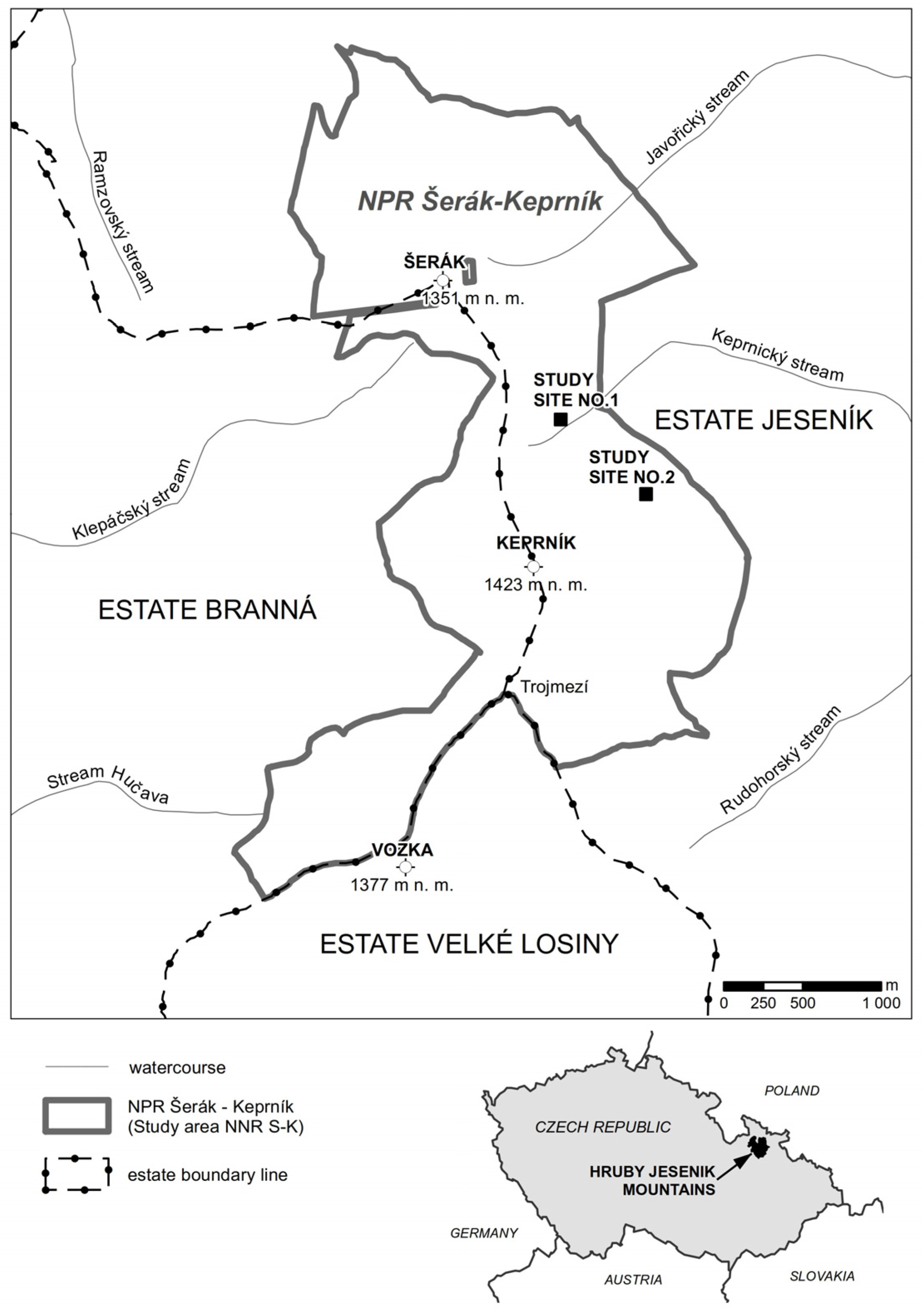
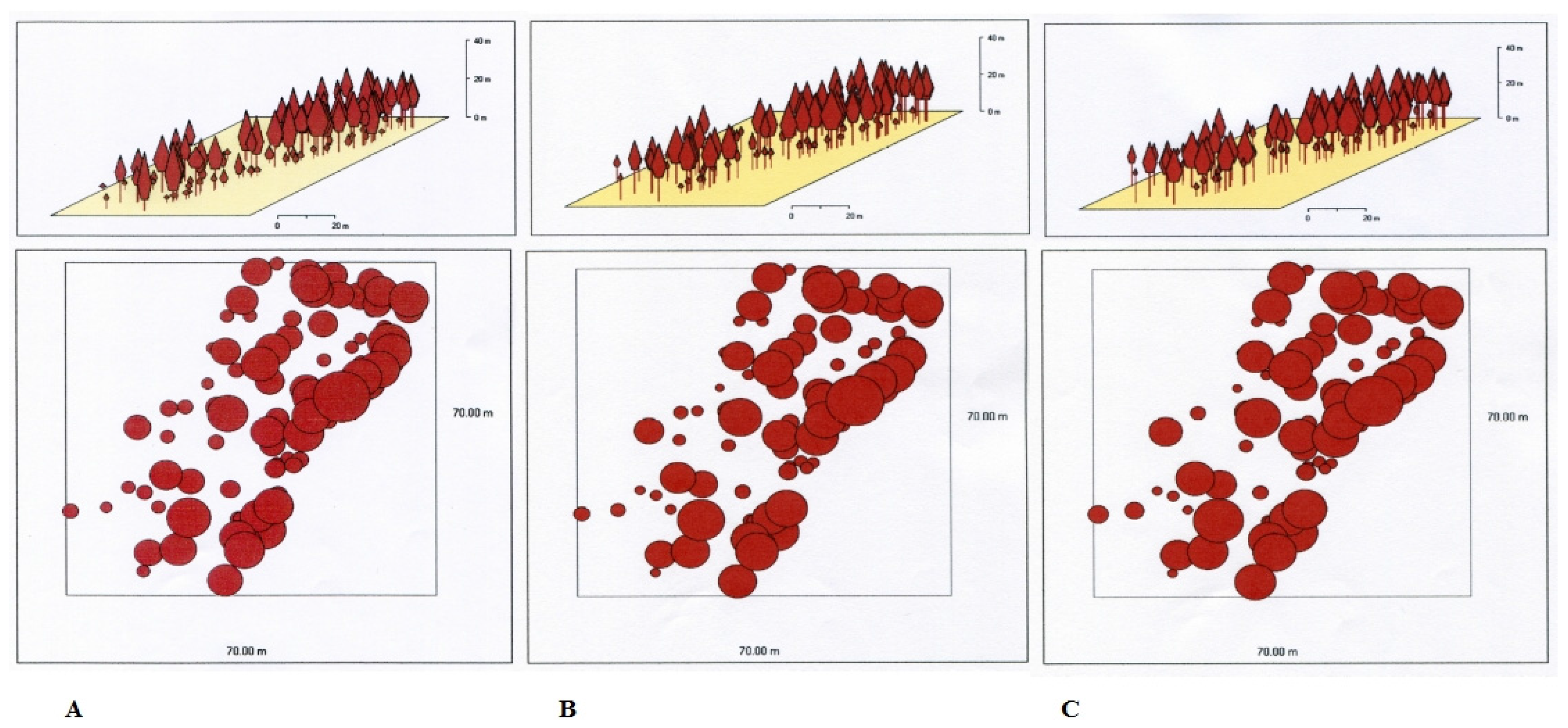
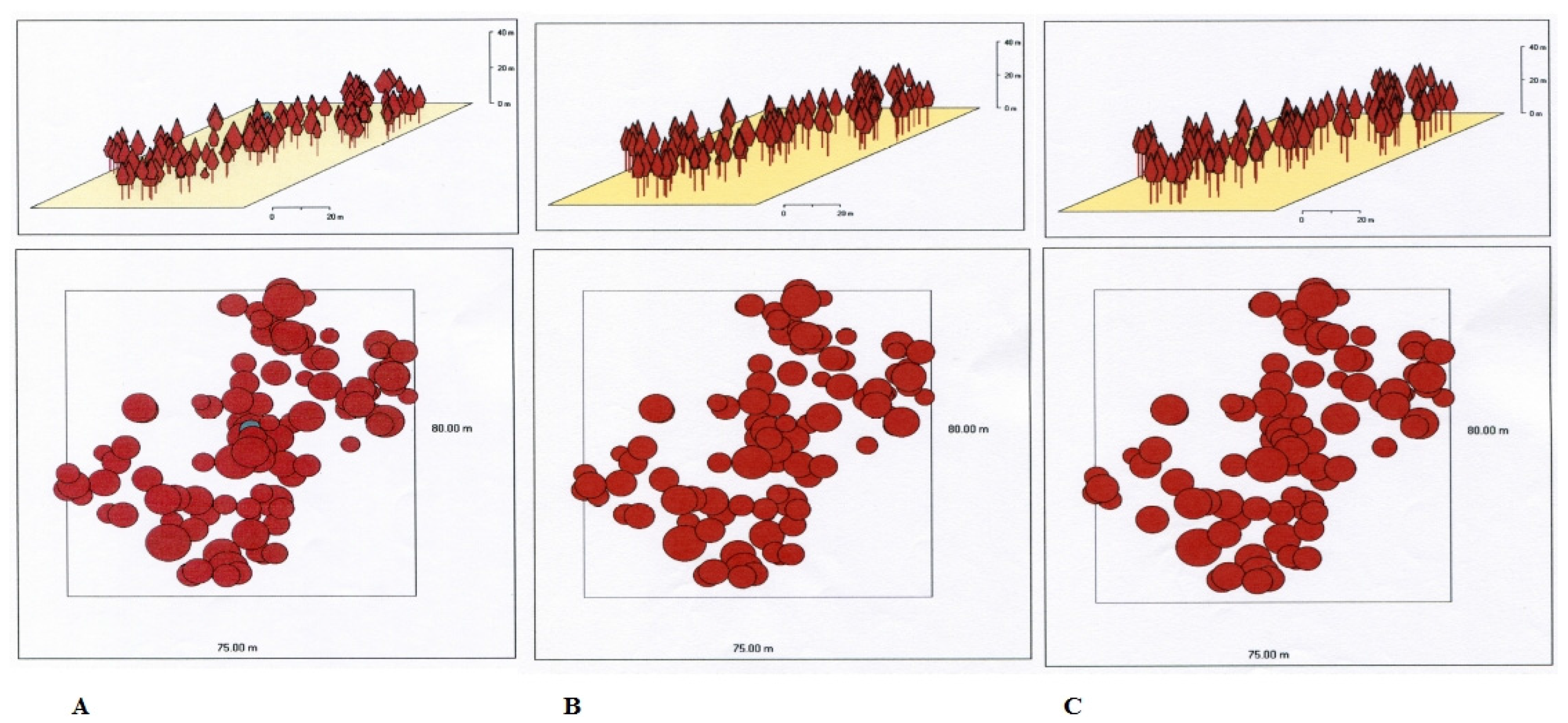
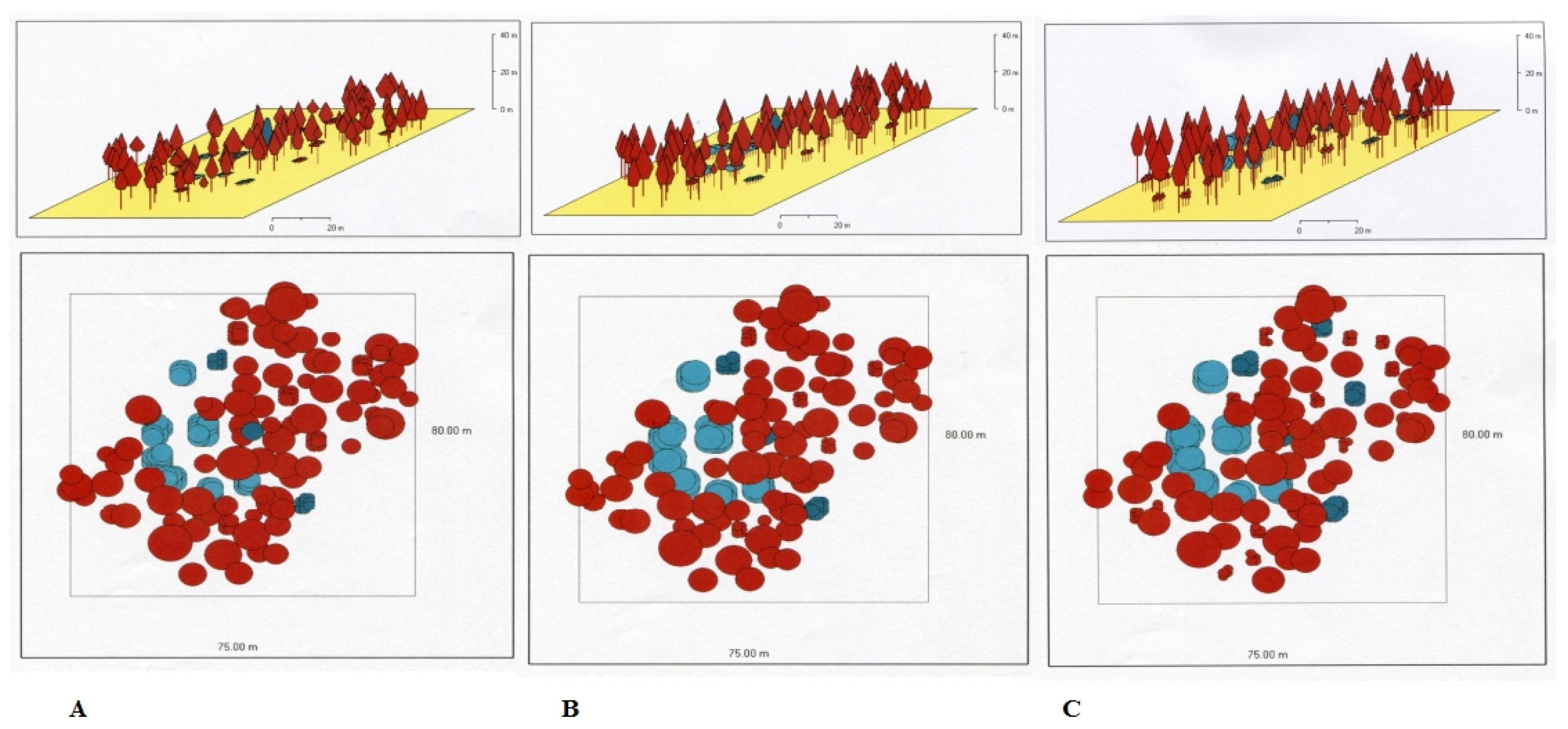

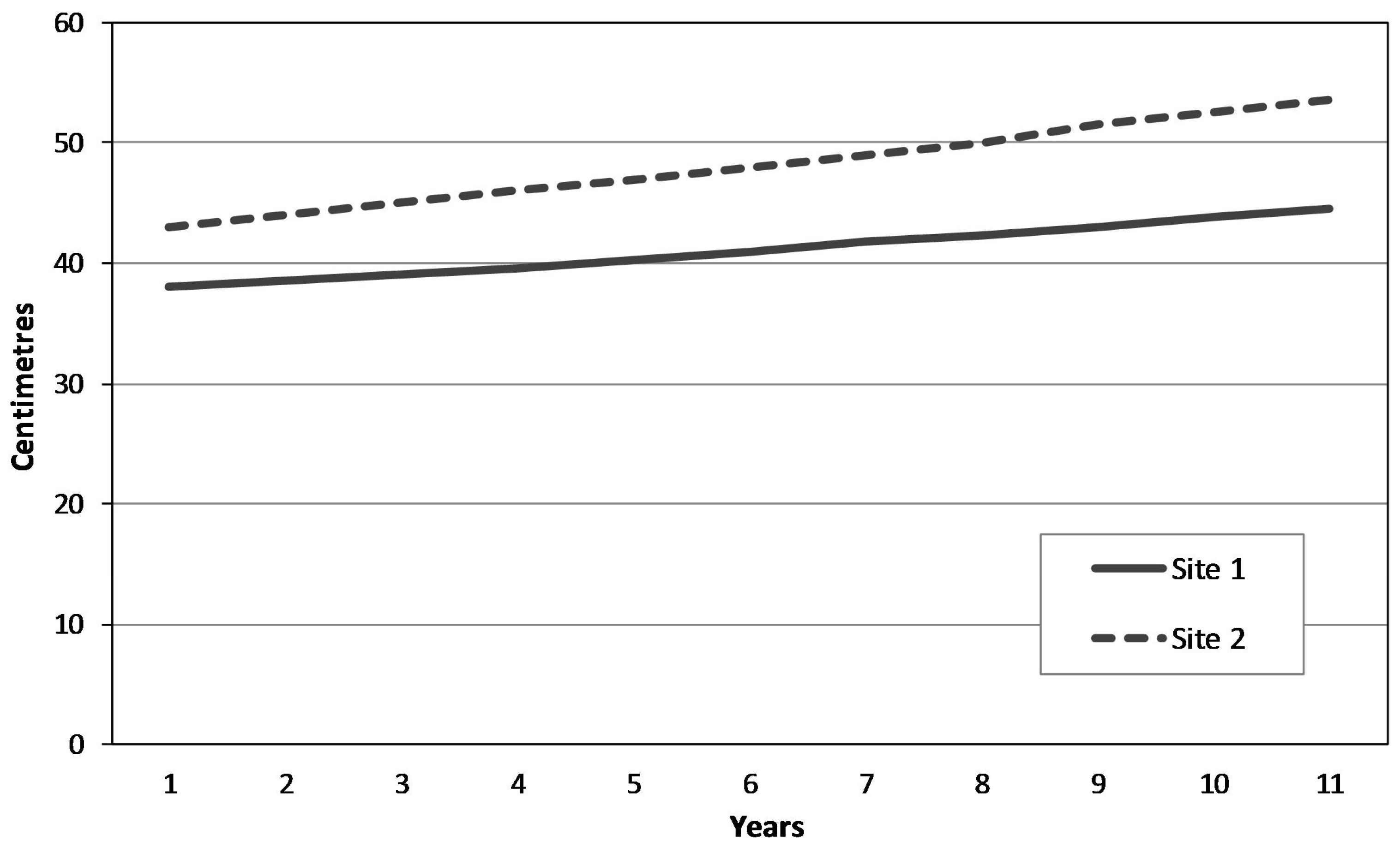
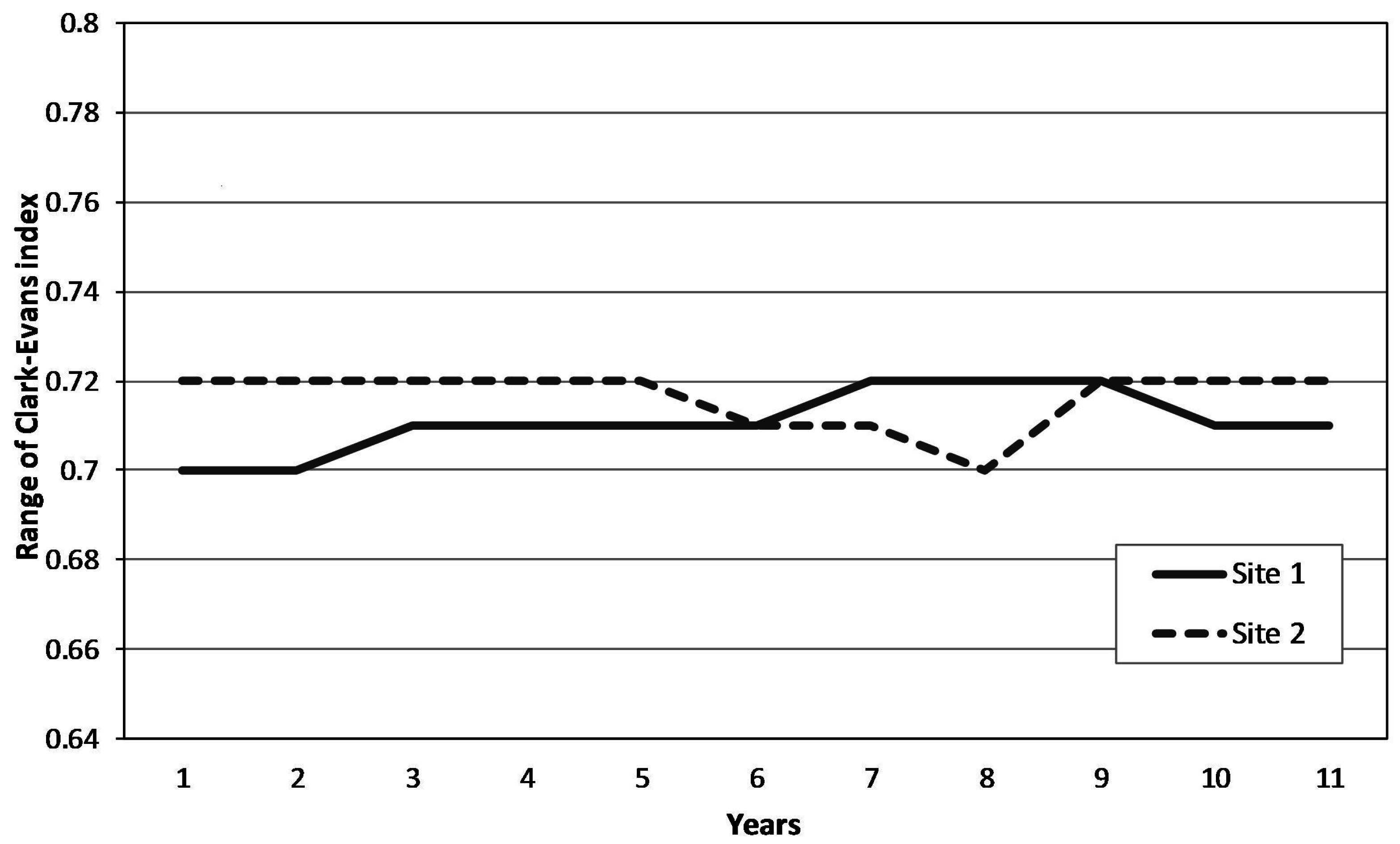
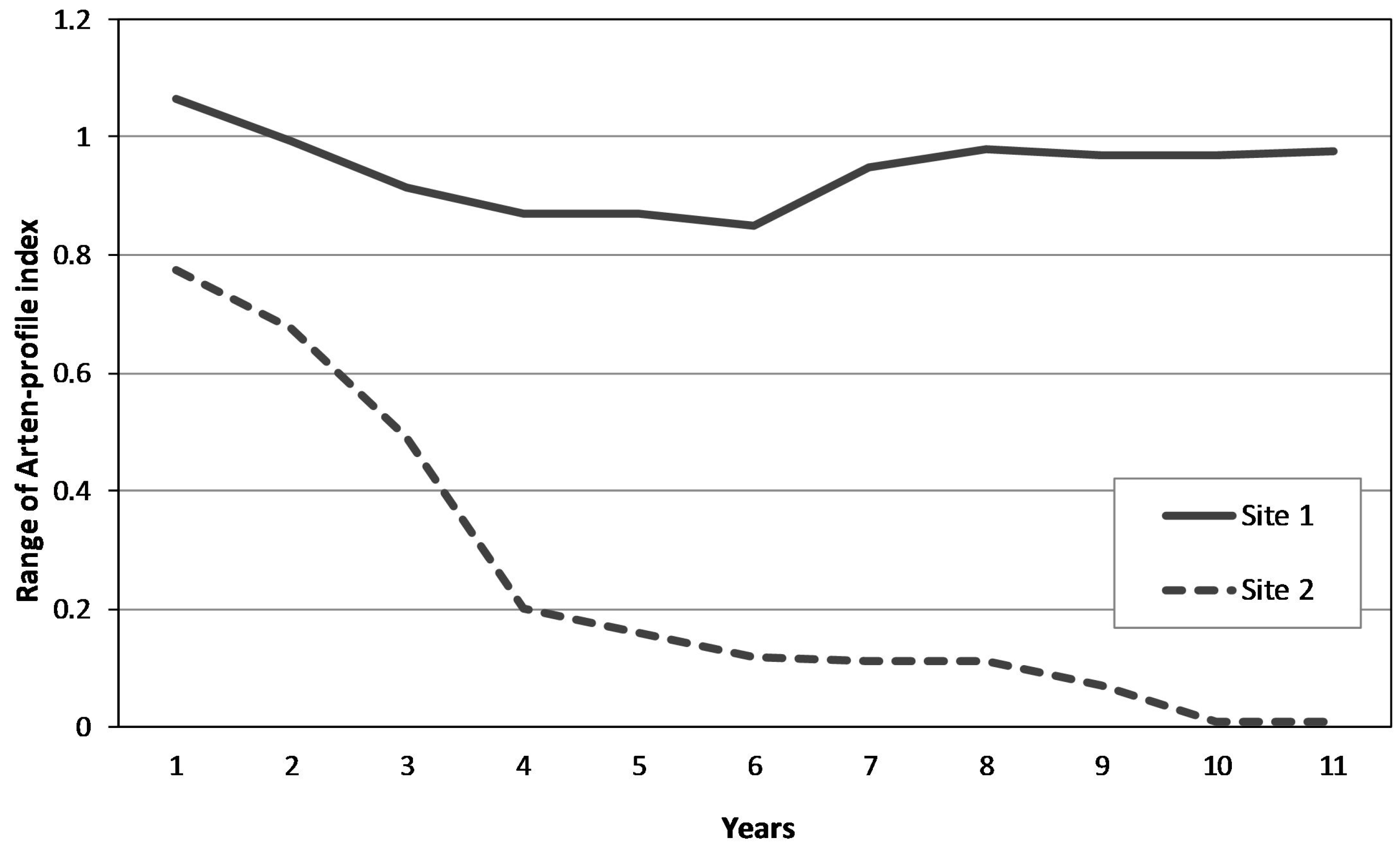
| Study Site | Proportion of Spruce (%) | Average Stand Height (m) | Median Diameter at Breast Height (cm) | Stem Sanding Volume (m3·ha−1) | Crown Canopy Average (%) | Stocking | Yield Level of Spruce | Age of Dominant Forest Tree Layer (Years) |
|---|---|---|---|---|---|---|---|---|
| 1 | 100 | 22 | 32 | 272 | 70 | 8 | 22 | 170 |
| 2 | 100 | 27 | 39 | 327 | 90 | 9 | 26 | 140 |
© 2016 by the authors; licensee MDPI, Basel, Switzerland. This article is an open access article distributed under the terms and conditions of the Creative Commons Attribution (CC-BY) license (http://creativecommons.org/licenses/by/4.0/).
Share and Cite
Machar, I.; Simon, J.; Rejsek, K.; Pechanec, V.; Brus, J.; Kilianova, H. Assessment of Forest Management in Protected Areas Based on Multidisciplinary Research. Forests 2016, 7, 285. https://doi.org/10.3390/f7110285
Machar I, Simon J, Rejsek K, Pechanec V, Brus J, Kilianova H. Assessment of Forest Management in Protected Areas Based on Multidisciplinary Research. Forests. 2016; 7(11):285. https://doi.org/10.3390/f7110285
Chicago/Turabian StyleMachar, Ivo, Jaroslav Simon, Klement Rejsek, Vilem Pechanec, Jan Brus, and Helena Kilianova. 2016. "Assessment of Forest Management in Protected Areas Based on Multidisciplinary Research" Forests 7, no. 11: 285. https://doi.org/10.3390/f7110285






